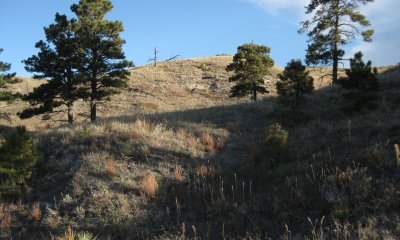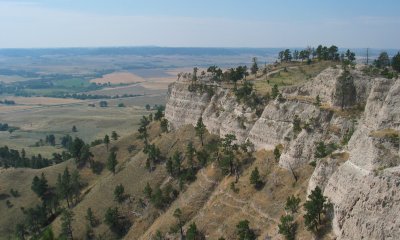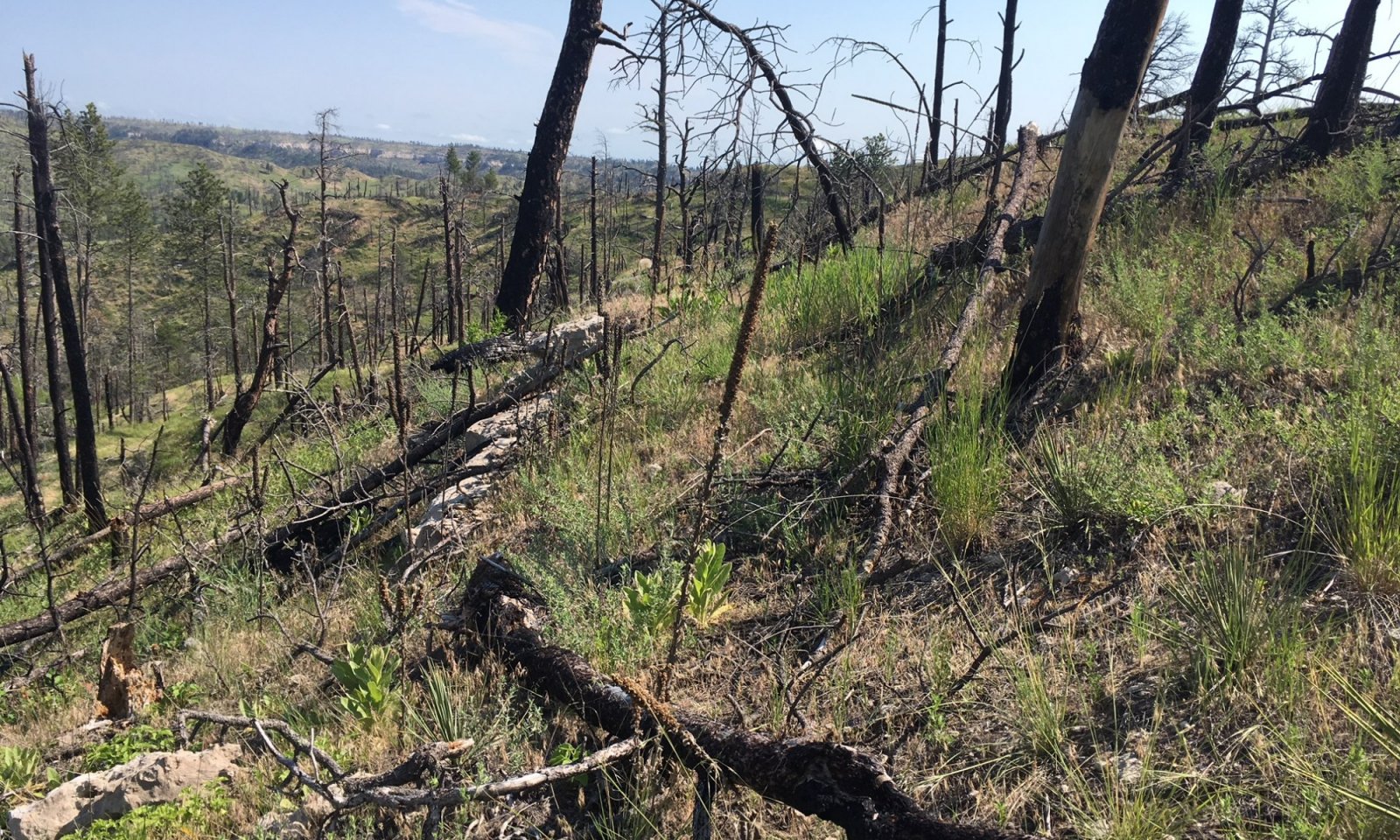
Shallow
Scenario model
Current ecosystem state
Select a state
Management practices/drivers
Select a transition or restoration pathway
- Transition T1A More details
- Transition T1B More details
- Transition T1C More details
- Restoration pathway R2A More details
- Transition T2A More details
- Restoration pathway R3A More details
- Transition T4A More details
- Transition T4B More details
-
No transition or restoration pathway between the selected states has been described
Target ecosystem state
Select a state
Description
The Reference State represents the best estimate of the natural range of variability that dominated the dynamics in this ecological site prior to European settlement. This site, in the Reference State, is dominated by warm-season grasses and subdominant cool-season grass. Forbs will be common and diverse, shrubs species will vary depending on precipitation, and slope aspect. Ponderosa pine and Rocky Mountain juniper can occur naturally on steep slopes and ridges adjacent to rock outcrops. Grazing or the lack of grazing, fire, and drought are the major drivers between plant communities.
Submodel
Description
The Shortgrass State is dominated by warm-season shortgrass species and upland sedges. This State is the result of grazing management that does not provide adequate recovery time for tall- and mid-statured warm- and cool-season grasses. The hydrologic function of this state may be altered. Runoff is high, and infiltration is low. The Shortgrass State is very resistant to change through grazing management alone.
Submodel
Description
The Early Successional State is dominated by weedy annuals and biennials, sand dropseed, threeawn, and field sagewort (green sagewort). This State is the result of heavy disturbance such as frequent and severe defoliation or heavy livestock concentrations coupled with grazing management that does not provide adequate time for recovery in the Reference State (1.0).
It can also be the result of a high-intensity fire and subsequent soil erosion in the Conifer State (3.0).
The hydrologic function is also likely to be dramatically altered. Runoff is high, and infiltration is low. The Early Succesional State is very resistant to change through grazing management alone.
Submodel
Description
The Conifer State occurs when ponderosa pine, Rocky Mountain juniper, or eastern red cedar become established or expand on this site. As conifer canopy cover increases, the herbaceous component will decrease, bare ground increases and pine needles build up and create a thick duff layer. As competition from herbaceous species decrease, conifers can establish more readily under the canopy. Heavy grazing can contribute to this transition, but it may also occur independently without human influence other than through fire suppression.
The Pine Ridge area of Nebraska is drier than the Black Hills (MLRA 62) where expansive stands of ponderosa pine occur, and pine regenerates readily following fire. Nebraska is not an area where ponderosa pines thrive as the state is at the southern and eastern edge of ponderosa pine range (Gaarder, 2013). Replanting is difficult because of the limited growing conditions for the species in Nebraska. Previous efforts to replant ponderosa pine in burned areas of northwest Nebraska, notably near Fort Robinson State Park (Gaarder, 2013), Chadron State Park, and East Ask Creek watershed have been largely unsuccessful (Nebraska Forest Service, 2013).
It would not appear that MLRA 64 has consistent climatic conditions necessary for ponderosa pine germination and regeneration. Those conditions may be episodic as they are in the drier American southwest. Regeneration of ponderosa pine in New Mexico and Arizona are strongly episodic and the basis of these pulses are at least partly controlled by climate. Ponderosa pine in the Southwest require a warm wet spring and an above-average water supply throughout the year for germination to occur and seedlings to establish. One study from northern Arizona showed a large cohort of ponderosa pine that established within a two-year period between 1919 and 1920 when optimal combination of temperature and precipitation factors occurred. This episodic event was not repeated for 73 years (Savage, M., et al, 1996).
The Conifer State on the Shallow ecological sites may be limited in extent, especially those plant communities having large ponderosa pine components. As high intensity, medium to large sized wildfires occur, these plant communities may become less common as grassland communities replace these woodlands.
Submodel
Mechanism
Continuous seasonal grazing, or continuous season-long grazing without change in season of use, or heavy grazing in combination with drought, will convert the plant community to Shortgrass Sod State (2.0).
Mechanism
Frequent and severe defoliation or heavy disturbance including livestock feeding areas, prairie dog towns, and calving pastures will transition this the Reference State (1.0) to the Early Successional State (3.0).
Mechanism
Long-term fire suppression, favorable climatic conditions that allow for pine regeneration and establishment, expansion of conifers, and time will lead to the Conifer State (3.0).
Mechanism
Long-term prescribed grazing, including proper stocking rates, change in season of use, and adequate time for plant recovery after grazing, may convert this plant community to the Reference State (1.0). A return to normal precipitation patterns following drought will help with recovery. This transition may not be rapid or meet management objectives.
Mechanism
Frequent and severe defoliation or heavy disturbance including livestock feeding areas, prairie dog towns, and calving pastures will transition this the Shortgrass Sod State (2.0) to the Early Successional State (3.0).
Mechanism
Removal of any management-induced disturbance coupled with long-term prescribed grazing, including proper stocking rates, change in season of use, and adequate time for plant recovery after grazing, may convert this plant community to the Shortgrass Sod State (2.0). A return to normal precipitation patterns following drought will help with recovery. This transition may not be rapid or meet management objectives.
Mechanism
Prescribed burning or wildfire followed by long-term prescribed grazing will move this plant community towards the herbaceous dominated Reference State (1.0). Mechanical removal of pine/juniper, either through bush management, timber harvest, or thinning, followed by long-term prescribed grazing may also allow the understory to develop and transition to the Reference State (1.0). Trees located on the steeper escarpments and deeper canyons may escape most fires and provide a seed source for ponderosa pine expansion in the future. This transition is most likely to occur from the Ponderosa Pine-Juniper < 15 Percent Cover/Herbaceous Understory Plant Community (4.1).
Mechanism
High-intensity fire, followed by excessive soil erosion will cause a transition to the Early Successional State (3.0). Initially weedy species including annual grasses and forbs, common mullein, and thistles will become established, eventually, upland sedges, shortgrasses, and dropseeds will dominate the plant community. Trees located on the steeper escarpments and deeper canyons may escape most fires and provide a seed source for ponderosa pine to expansion in the future. This transition can occur from any plant community within the Conifer State (4.0) but is more likely to occur from the Ponderosa Pine-Juniper > 20 Percent Cover/Duff Buildup Plant Community (4.2).
Model keys
Briefcase
Add ecological sites and Major Land Resource Areas to your briefcase by clicking on the briefcase (![]() ) icon wherever it occurs. Drag and drop items to reorder. Cookies are used to store briefcase items between browsing sessions. Because of this, the number of items that can be added to your briefcase is limited, and briefcase items added on one device and browser cannot be accessed from another device or browser. Users who do not wish to place cookies on their devices should not use the briefcase tool. Briefcase cookies serve no other purpose than described here and are deleted whenever browsing history is cleared.
) icon wherever it occurs. Drag and drop items to reorder. Cookies are used to store briefcase items between browsing sessions. Because of this, the number of items that can be added to your briefcase is limited, and briefcase items added on one device and browser cannot be accessed from another device or browser. Users who do not wish to place cookies on their devices should not use the briefcase tool. Briefcase cookies serve no other purpose than described here and are deleted whenever browsing history is cleared.
Ecological sites
Major Land Resource Areas
The Ecosystem Dynamics Interpretive Tool is an information system framework developed by the USDA-ARS Jornada Experimental Range, USDA Natural Resources Conservation Service, and New Mexico State University.




